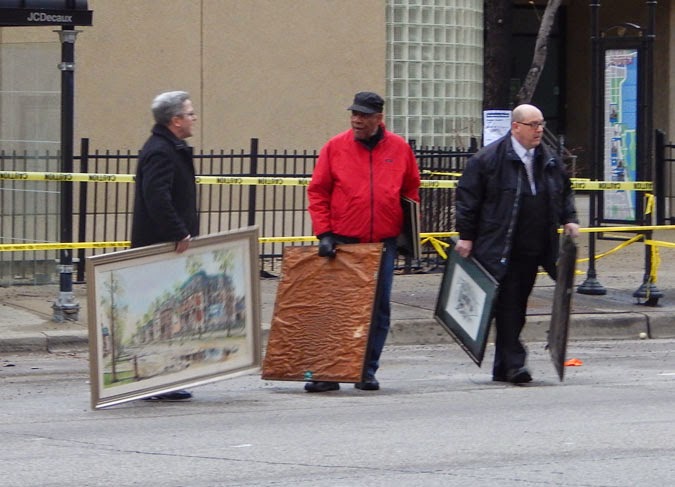In a few days, the world will bid farewell to another year and usher in
2015. In celebration, we take a brief
look back at how the Glessners and a few of their fellow Chicagoans welcomed in
the year 1900.
The Glessners celebrated with a small gathering in their home which was
greatly enhanced by the arrival of their dear friend, Theodore Thomas,
conductor of the symphony orchestra, and a few of his musicians. Frances Glessner related the following in her
journal for Sunday December 31, 1899:
“Mr. & Mrs. Philo
Otis, Miss Hutchinson, Frances, Mr. Badger, Mr. Hendricks, Mr. Hendrickson came
to supper. Mr. Hendricks and Mr.
Hendrickson left at 10. Mr. Thomas came
in between eleven and twelve. At twelve
we were congratulating each other when the most beautiful music seemed to fill
the whole house. Mr. Thomas had brought
in eight or more members of the orchestra into the dining room. The doors were shut into the dining room, and
the whole house seemed filled with harmony.
The men played German chorales.
Then the doors were opened, we went out and wished every one a happy new
year, after that the men played burlesques on a German street band. We were moved to tears in the first part, and
nearly hurt ourselves laughing over the other part. We had some sandwiches, champagne, and mulled
wine – and a very delightful time.”
Theodore Thomas
From the Chicago Tribune we
get a glimpse of how others in Chicago were celebrating. Midnight masses and “watch night” services
were common in many of the churches as indicated below:
“The dawn of the ‘holy
year’ in Chicago found the many churches where midnight mass was sung
surrounded by great throngs of people.
Every edifice was crowded, the aisles were filled, and many stood in the
vestibules, but could hear or see little of the services. At the Cathedral of the Holy Name, North
State and Superior streets, and at the Holy Family Church, May and Twelfth
streets, the crowds were greatest. At
both these were special details of police and detectives.
“At the North Side
Cathedral the crowd began to gather soon after 8 p.m. By 11:30 there was a crowd of 2,000 people
around the church. Shortly before
midnight a small door was opened, and through this the crowd filed slowly till
the church was filled. Hundreds were
turned away disappointed.
Holy Family Church and St. Ignatius
“The Holy Family
Church, Twelfth and May streets, which has the largest congregation of any
Catholic Church in the city, was crowded long before midnight. Solemn high mass was sung, and the music and
floral decorations were fitting for the celebration.”
Cycling clubs, extremely popular at the turn of the last century,
provided appropriate entertainment and activity. The Board of Trade Cycling Club gave an
annual entertainment, consisting of a minstrel show with club members taking
all of the roles. T. J. Cannon, the
master of ceremonies for the show, was in Colonial costume and powdered wig; others
performers were in black face.
Cyclists on the porch of a Pullman home
The Chicago Cycling Club continued their annual tradition of a ride to
Pullman:
“Members of the
Chicago Cycling club having an authenticated record of 2:50 for a mile unpaced
will start at 10 o’clock this forenoon on their fourteenth annual New Year’s
day run to Pullman. . . The annual run has been held in all sorts and kinds of
weather in the thirteen years in which it has flourished. Roads from the consistency of mush to the
frozen pathway which will be found today have been religiously whirled over by
the pioneers of Chicago cycling every year.
Sometimes they rode in snow, sometimes in rain, sometimes in a
combination of rain and snow; but they have always ridden the course and
finished up with a big dinner at Pullman . . . Twenty-five or thirty riders
have signified their intention of taking the run today. Probably not more than fifteen will turn out,
but these will be the oldest riders of the lot.
The younger generation do not take as kindly to the hardships of the
task as do those who first burned the pathway for the bicycle in Chicago.”
The holiday was also celebrated with many parties and receptions including
these two on the South Side:
“Two entertainments
with which the week closed were given by Mrs. Chauncey Blair and Mrs. Arthur
Caton last evening (December 31). Mrs.
Blair gave an old-fashioned farm supper and dance for the young people. Pumpkins, jack-o’-lanterns, and other novel
features were used in decoration. Mrs.
Caton gave a dinner for nearly fifty guests, followed by a vaudeville entertainment. The program was supplied entirely by
amateurs.”
Caton dining room, 1910 S. Calumet Ave.
NOTE: The Chauncey Blair
residence was at 4830 S. Drexel Boulevard.
Regardless of how you choose to ring in 2015, we wish our readers a
happy, healthy, and prosperous New Year!













































